Get PeakVisor App
Sign In
Search by GPS coordinates
- Latitude
- ° ' ''
- Longitude
- ° ' ''
- Units of Length
Share×

Scan the QR code and open PeakVisor on your phone
❤ Wishlist ×
Choose
Delete
The Cristallo group (Gruppo del Cristallo) is one of the major mountain groups in the Dolomites of northern Italy. It is known among outdoor enthusiasts for two main reasons: The Misurina Lake (one of the most beautiful in the region) and Ponte Cristallo, which is the longest suspension bridge in the area. The highest and the most prominent peak out of the 25 named mountains in the Gruppo del Cristallo is Monte Cristallo (3,221 m / 10,567 ft).
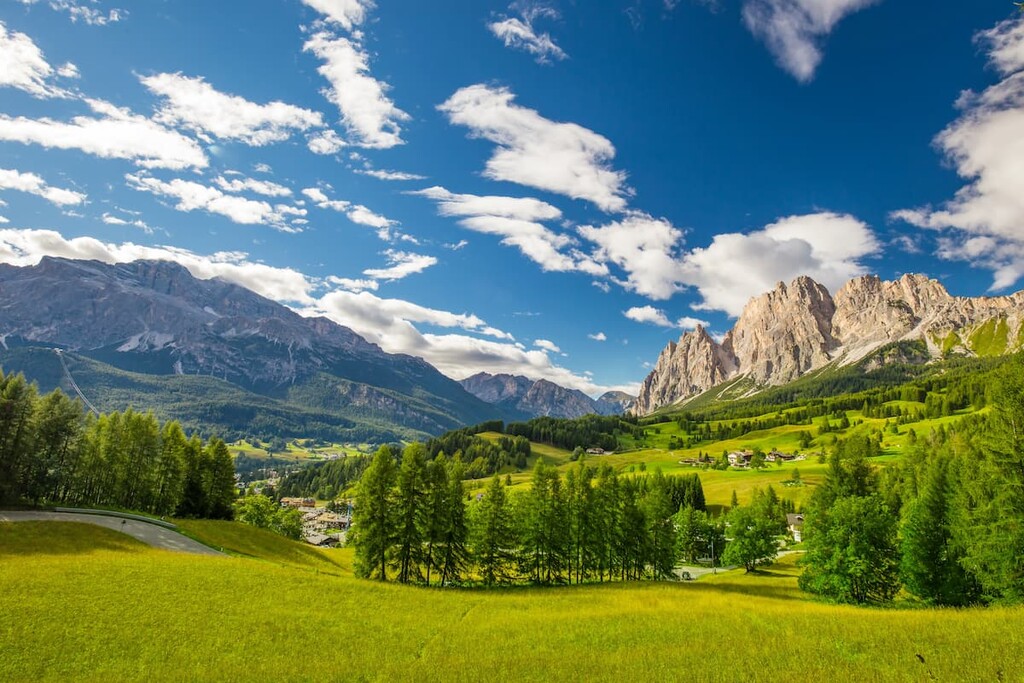
The name of the main peak in the Gruppo del Cristallo (Monte Cristallo) translates as “Crystal Mountain.” Cristallo is an Italian-Venetian word that translates to “rock crystal” in English. This is an unofficial name of quartz, a hard, crystalline mineral with a very transparent, glass-like appearance.
The word cristallo first appeared in Venice on the famous island of Murano, when the local glass makers tried to recreate rock crystal in their attempts to make the purest and transparent glass, without yellow flecks. This material later became known as crystal or lead glass (vetro cristallo).
For the first time in Italy, this type of glass was invented by the famous Venetian glass artist Angelo Barovier in 1450. He is also, and above all, known as the author of many things made from Venetian glass or Murano glass.
The name of the main range, the Dolomites, also refers to the mineral dolomite. This mineral is found both in Cristallo and throughout other mountains in the region. It is not transparent, like quartz, but it is mostly light in color. As a result, it can sometimes look a lot like a crystal, particularly when it turns into different colors at sunset and sunrise.
I’ve been to Cristallo twice, and I’ve also seen many other mountains in the Dolomites, and in my opinion, this mountain group is aptly named. It stands out among the others for its pure, almost transparent, rocks and geologic features. It seems that when you look at Cristallo, you can look through it.
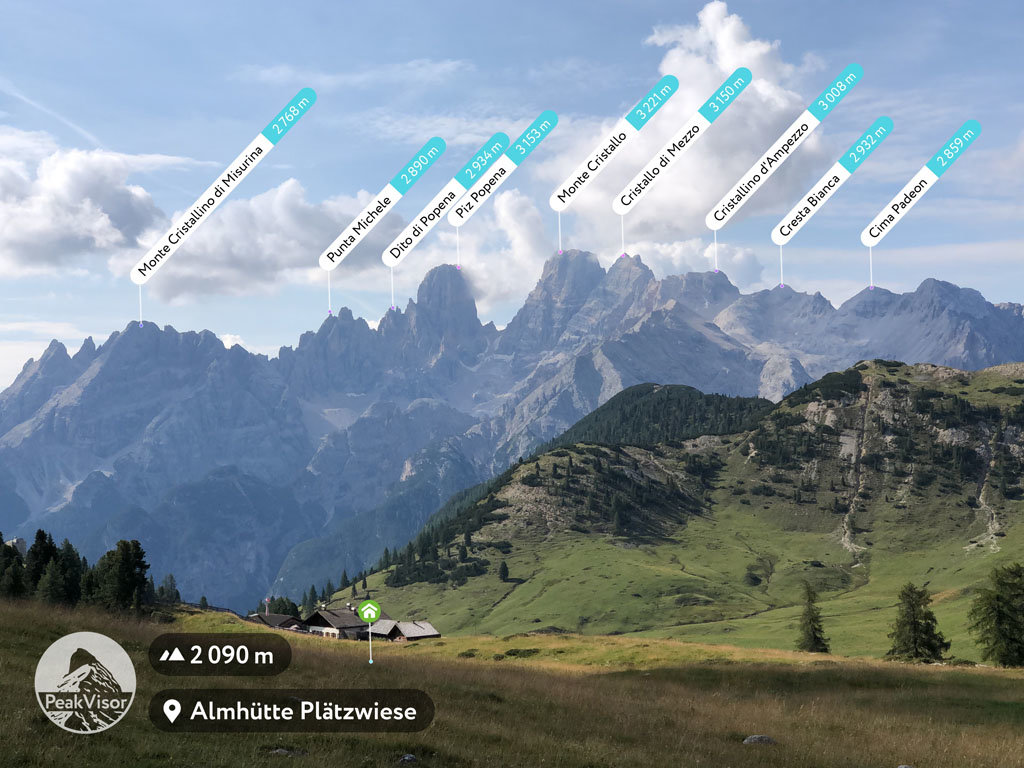
The Gruppo del Cristallo is located in the Belluno province in the Veneto region in the north of Italy. However, a small part of the group in its northern part belongs to the Trentino—Alto Adige / South Tyrol region. On the border of the two regions is the Rauhkofel—Monte Scabro (2,126 m / 6,975 ft) peak.
At the same time, about half of the southern part of the group, as far north as the peak of Monte Cristallo, is also part of an Ampezzo Dolomites Nature Park (Parco naturale delle Dolomiti d’Ampezzo). It is one of eight such parks in the Dolomites, along with Tre Cime Nature Park, Paneveggio-Pale di San Martino Nature Park, and Adamello-Brenta Nature Park, among others.
Cristallo is surrounded by other famous peaks and groups: first of all, it is the small Pomagagnon Group, consisting of only seven peaks, southwest of it. In fact, the relief of this group repeats the outlines of the southern borders of Cristallo in the form of an arc in a direction from northwest to southeast.
To the north of Cristallo there is the Hohe Gaisl, or Croda Rossa d'Ampezzo in Italian, (3,146 m / 10,321 ft) peak on the southern border of the Pragsen Dolomites. Meanwhile, the Fanes Group, Tofana di Mezzo (3,244 m / 10,643 ft) in the Tofane Group, and Nuvolau and Croda da Lago groups are located to the west.

The largest peak to the southeast of Cristallo is Punta Sorapiss (3,205 m / 10,515 ft) in the Sorapiss Group. To the east, there is Monte Piana (2,324 m / 10,905 ft) and the famous symbol of the whole Dolomites, Tre Cime di Lavaredo, in the Sexten Dolomites.
The Cristallo is very close to the unspoken capital of the Dolomites, Cortina d’Ampezzo. The distance from the village to the Tre Croci Pass in the valley of Val Begontina almost at the foot of the mountains is about 7 km (4.3 mi).
Before 2016, there was a cable car, with which you could travel to the Forcella Staunies (2,919 m / 9,576 ft) in the Cristallo Group from this pass, but it was closed due to the fact that it had become old since being launched for the Winter Olympics in 1956, and no new cable car has yet been built. Perhaps it will be re-opened for the Cortina Winter Olympics, which will be held in 2026.
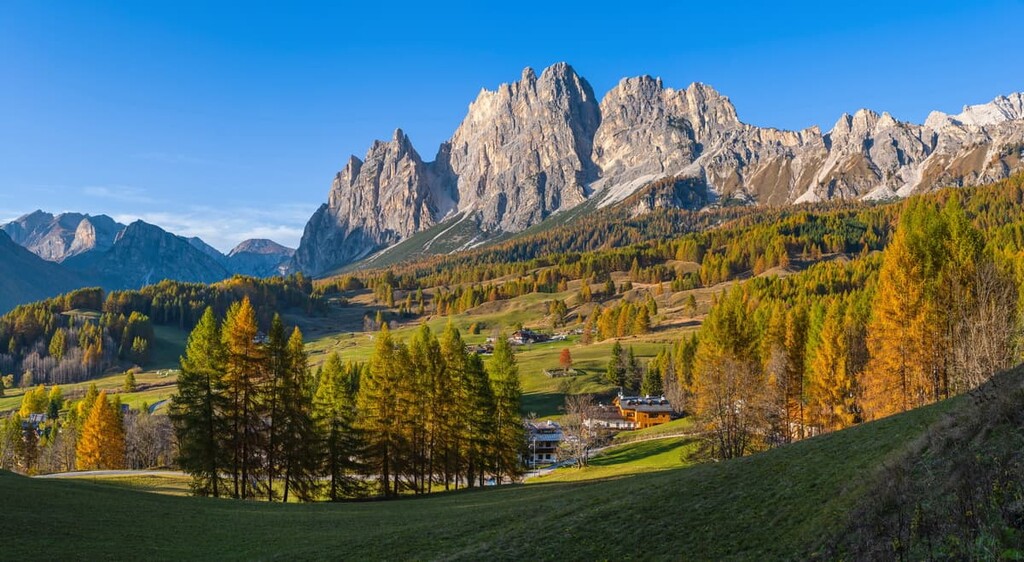
The easiest way to get to Cortina is from Belluno, the capital of the province, which, in turn, is easiest to get to from Treviso and Venice. In this order, the way by car takes 193 km (119.9 mi) or 3 hours and 15 minutes. There are international airports in both cities—Venice Marco Polo Airport and International Airport Treviso A. Canova—with flights from all the world’s leading airlines, including the local Alitalia.
The mineral dolomite began to form in the Mesozoic Era about 220–250 million years ago when much of present-day Europe was covered by the ancient Tethys Ocean.
The mineral formed as a result of accumulating deposits of corals and other sea creatures on the seafloor. Over time, these accumulations formed atolls or coral islands in the ocean. Over the course of millions of years, the water slowly receded and the islands became mountains as a result of the collision of the European and African tectonic plates.
Millions more years have passed since this initial mountain building event. Since then, the Dolomites have become what we know of them today as a result of volcanic eruptions, weathering, and other natural processes.
You don’t need microscopes and other tools to see this unimaginable geological history today—you just need to come to these mountains and hike them with the PeakVisor app. In certain mountains, such as Tofane, Pale di San Martino and Sella, geological layers can be seen with the naked eye. This is why the Dolomites are also often called “An Open Air Geological Museum.”

The landscape of the Cristallo Mountains is formed by its highest peaks, surrounding valleys, passes, and neighboring mountain ranges.
Speaking of peaks, the group is quite homogeneous and, I would even say, monolithic, almost oval in form, unlike some other groups, including its closest neighbor, Tre Cime di Lavaredo, which looks like a three teeth or towers. Check it on the 3D maps in the PeakVisor app—it’s very handy.
On the main peaks of the Gruppo del Cristallo, there are two small glaciers: Ghiacciaio del Cristallo and Ghiacciaio del Popena in the Val Fonda glacier valley.
Cristallo is surrounded five large valleys formed mainly by the rivers of the same names:
A fifth large valley, Val Padeon, separates Cristallo from the neighboring Pomagagnon Group.
There are also two passes here: Cimabanche Pass / Im Gemärk / Sorabances (1,529 m / 5,016 ft) and Tre Croci Pass / Son Zuógo (1,809 m / 5,935 ft).
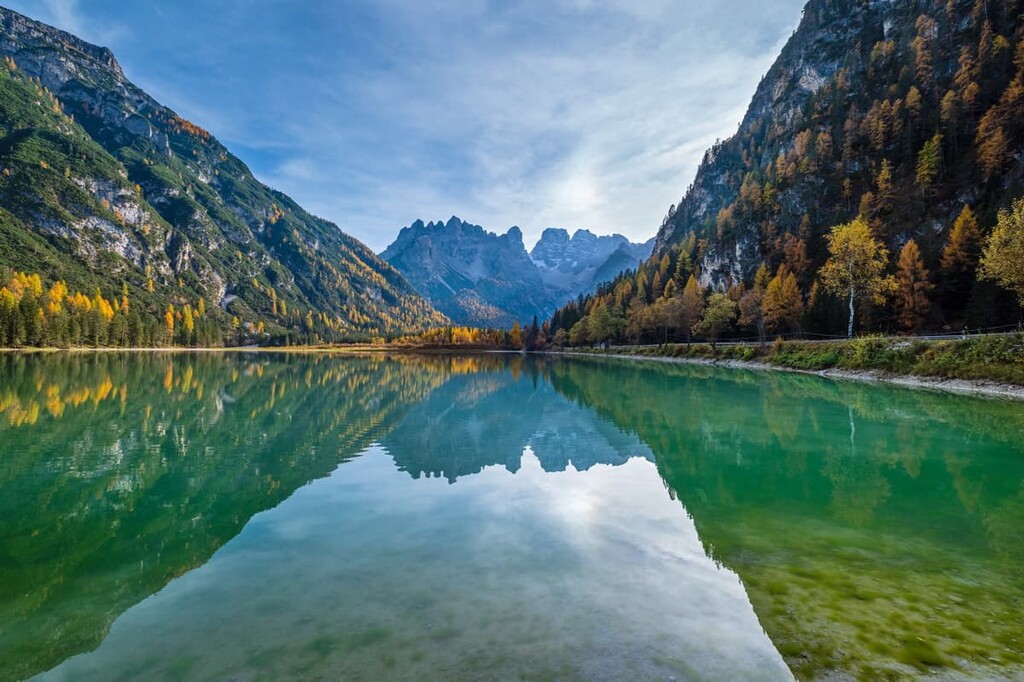
The landscape of the Cristallo Group just cannot be imagined without Misurina Lake, which lies to the southeast of the group.
It is a small lake that’s just 2.5 km (1.5 mi) long with a maximum depth of 5 m (16 ft), located at an altitude of 1,754 m (5,755 ft), but it is very popular. Just as the Latemar is known for the view from Carezza Lake, Cristallo is known above all for Misurina.
However, do not confuse Cristallo with the Sorapiss, which is also visible from the lake. I'm talking about one of the most postcard-like views in the Dolomites with the yellow "hotel" against a background of a mountain wall that is reflected in the waters of the lake, which you have probably already seen online many times searching for the Dolomites.
The Sorapiss is located at a distance from the lake, so it is more visible than Cristallo, which starts right at the shores of the lake. It is Sorapiss on this postcard, not Cristallo.
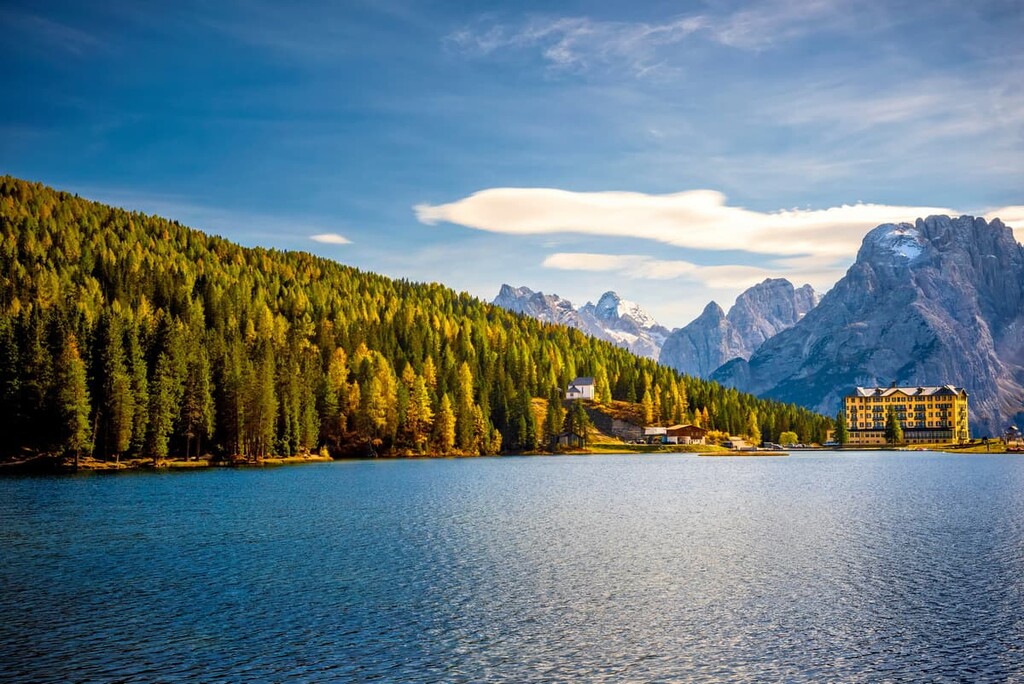
There is another common misconception on this view—the yellow building with green shutters. Read about it in the guide to Sorapiss Group.
The Gruppo del Cristallo belongs to the Dolomites, which are also known as the Prealps or the Italian Alps. This group belongs to the Southern Limestone Alps of the Eastern Alps (number 52) of the German-Austrian AVE classification.
Further, the group belongs to a larger subgroup within the Dolomites called Dolomiti Ampezzane, which also includes such groups as Tofane, Antelao, Sorapiss, Nuvolau, Croda da Lago, and others.
The Cristallo Group itself is also divided into several parts, but not many like some other mountain chains. For example, according to another commonly accepted classification, the Italian SOIUSA, in the group, there is a subgroup of Cristallo, with the main peak, and a subgroup of Popena with the main peak of the same name.
The group has five peaks higher than 3,000 m (9,842 ft):

The next five highest peaks of the Cristallo group in the top 10 are:
The group also has 18 peaks from 2000 to 3000 m (6,561 to 9,842 ft). The two lowest peaks are Col S. Angelo (1,793 m / 5,882 ft) right on the Misurina Lake and Colle Valfonda (1,790 m / 5,873 ft).
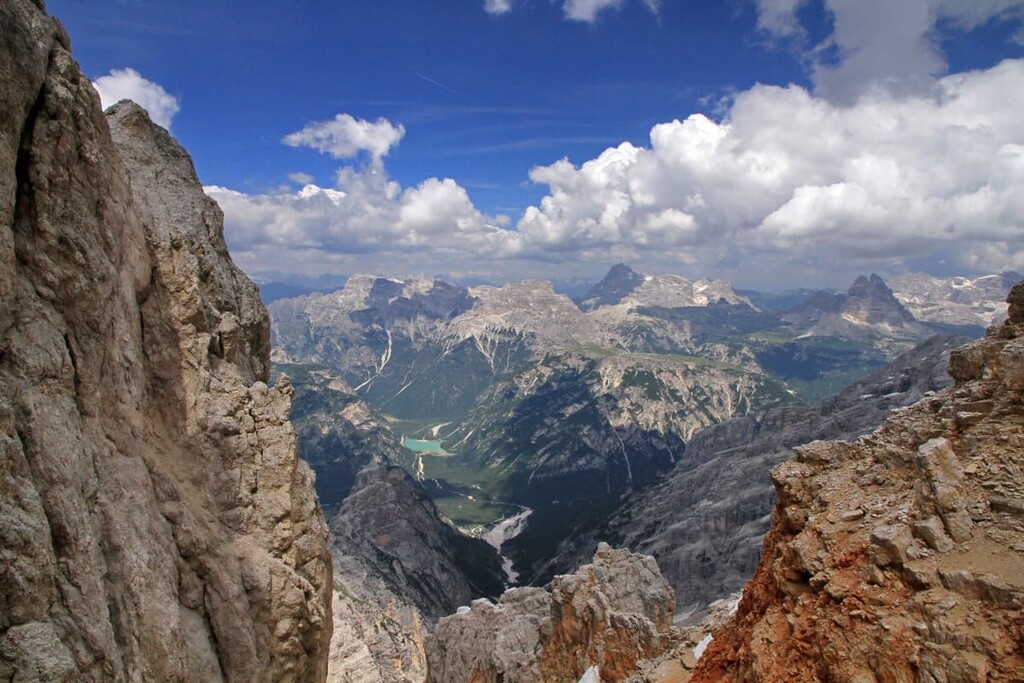
Two of the five highest peaks of the group—Cima di Mezzo and Cristallino d’Ampezzo—can be reached from via ferratas, so you don’t need to be a mountaineer. But if you are one, you can climb the other two of the five highest peaks of the group (and some smaller ones) using ropes and other equipment. Get inspired by examples of these great climbers of the past:
For a relatively small group, Cristallo has about a dozen hiking and climbing trails of varying lengths and difficulty that are suitable for both short walks and real adventures in the high mountains. One of them even appeared in a famous Hollywood movie from the 1990s. I will briefly tell you about the main trails:
The Misurina Lake Loop is an easy walking route around one of the most famous lakes in the Dolomites. It is usually taken by those who vacation on the lake for at least a day, but I had enough time to do it as part of the Tre Cime di Lavaredo hike in August 2013 and in July 2017.
In fact, here, at the Misurina Lake, you make the last transfer to the bus that takes you up to rifugio Auronzo at the foot of the most famous peak of the Dolomites, which is as visible from the lake as Cristallo.

Also on a side note, there’s at least one small outdoor store where you can buy hiking shoes and some other gear, if you forget something at home or need extra equipment.
The hike to Cristallino di Misurina Mountain is a nice and easy trek up the mountain Cristallino di Misurina (2,768 m / 9,081 ft) in the eastern part of the Cristallo Group.
You can start this hike from one of the two farms around Misurina Lake: Malga Musina at the southern tip of the lake or Malga Popena to the north of the lake. On the trail, the scenic Monte Popena will remain to your right or left as you hike, depending on the route you choose.

You can also do a loop hike around Monte Popena and climb it via a separate smaller trail, but I recommend the Cristallino di Misurina route, because the mountain is 500 m (1,640 ft) higher, which means you will see much more—not only the lake itself but more of the surrounding mountains, including Tre Cime di Lavaredo from an unusual angle that is not usually printed on postcards.
The Albergo Ospitale—Rifugio Son Forca trek is a relatively easy yet very scenic route in Val Padeon, which, I will remind you, separates Cristallo from the neighboring Pomagagnon.
This hike takes you walking between two mountain huts where you can spend the night at the start and finish of the route. Along the way, you will see all the main peaks of both mountain groups and enjoy peace and tranquility away from the main hiking trails like at the Misurina.

Rifugio Son Forca is a typical Alpine hut with shared rooms (I’ll tell you about it a little later), and Albergo Ospitale is a typical Italian and Alpine hotel, where you can rent one of eight double rooms or enjoy a meal at the restaurant.
Alta Via 3 is one of the eight longest high alpine hiking trails in the Dolomites, traversing the range from north to south. The Alta Via 1 and Alta Via 2 are the most popular (like 10 times more popular), so this third route is for those who also want to find more solitude in nature and spend hiking as a time for self-reflection and thinking.

It is 100 km (62.1 mi) long and takes 8 days to complete. If you start from the very beginning in the Villabassa / Niederdorf in Pusterìa Valley in South Tyrol, you will go around the whole Monte Cristallo from the easter side during the second day from rifugio Vallandro to rifugio Vandelli passing also the Misurina Lake. Still, there’s a lot to see on the way when compared to Alta Via 1 and Alta Via 2.
In the Cristallo group, there are three major via ferratas that will allow you to pass the difficult sections of the range without technical climbing equipment or experience. But you will need a special via ferrata kit, consisting of a helmet, carabiners, and rope.
The most famous of the three routes is Via Ferrata Ivano Dibona. It starts near the former cable car station at the Forcella Staunies and leads to the top of Cristallino d’Ampezzo over the longest suspension bridge (27 m / 88.5 ft) in the whole Dolomites (Ponte Cristallo).
In 1993, Hollywood actor Sylvester Stallone ran across this very bridge during the filming of the key final scene of the movie Cliffhanger. Yes, the famous ’90s movie was filmed on Monte Cristallo as well in the surrounding mountain groups.
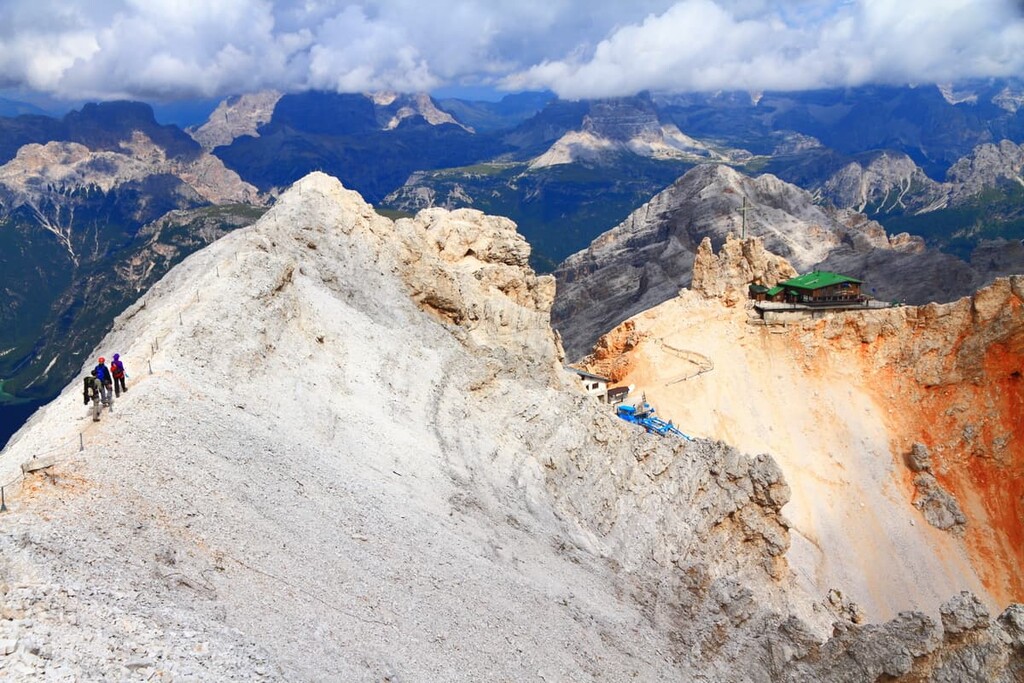
There were bullets and explosions all around Stallone and his girlfriend during the movie, but while you don’t need to expect anything like that during your trip, be prepared for your portion of the thrill. I do not recommend this route for those who are afraid of bridges or heights.
Another feature of the trail is that it is a historical trail that was built by the Italian military during World War I. Other traces of the war—bunkers, tunnels, fortifications, and others—can also be found on the route, as well as in the Cimabanche and Tre Croci passes.
On the way back, you will also overcome two other important peaks in the Cristallo Group: Punta del Forame Zurlong (2,156 m / 7,073 ft), and Col di Stombi (2,168 m / 7,112 ft).
Finally, speaking about accommodation on the route, closer to its start, there is also the Buffa di Perrero bivouac at 2,760 m (9,055 ft), where you can spend the night before climbing Cristallino d’Ampezzo if you go clockwise along the route.
The two other via ferratas of the Cristallo Group are the much shorter Via Ferrata Marino Bianchi, which starts also at the Forcella Staunies and leads to Cristallo di Mezzo, and Via ferrata Renato de Pol, which starts at the Pian di Forame to the southwest of Cimabanche Pass and leads to the top of Vecio del Forame (2,863 m / 9,393 ft).
Like almost everywhere in the Italian Alps, in winter you can ski and snowboard in the Cristallo Mountains. It is part of Cortina D‘Ampezzo Ski Resort, one of the 12 large ski areas of the Dolomiti Superski system. The Cristallo area itself is called Faloria-Cristallo-Mietres. It is one of the 16 ski resorts of the Dolomiti Superski system under the name of Faloria—Cristallo—Mietres.

To get up to the mountains you can take one of the seven cable cards leading to Mount Cristallo and Mount Faloria. The ski runs start directly from Cortina d’Ampezzo, including the black diamond (difficult) 1956 Winter Olympics giant slalom route called "Vitelli."
On Mount Cristallo itself, there are three red ski slopes (Padeón, Creste Bianche, and Rio Gere) and one blue run (Son Forca). Around the rifugio (restaurant) Mietres, there is a ski-touring trail. In total, the resort has 15 trails (2 blue, 9 red, and 4 black) for a total length of 16 km (9.9 mi).
You can also ski in the area of Misurina Lake, where there are 2 red slopes (Col de Varda and Mazzorana), one black (La Pala) and one blue ski trail (Loita).
Check out the map of ski trails on the Dolomiti Superski website.
Check the Cristallo ski map on the larger Veneto and Italy ski maps in the World Mountain Lifts section of the site. It includes information about open ski lifts / slopes in the Cristallo Group of the Dolomites in real-time with opening dates and hours. There are also year-round cable cars, funiculars, cog railways, aerial tramways, and all other types of mountain lifts.
There is one mountain hut in the Cristallo Group, rifugio Son Forca, where you can spend the night while hiking. It doesn't differ much from other typical huts in terms of general living conditions and quality of service, but it differs in terms of furnishings, history, and other aspects, which you can learn about during your visit.
At the hut, you can rent a bed in a common room for 4–12 people and order dinner and breakfast for an additional fee. A bed with breakfast and dinner in Italian is called a “mezza pensione” or half board. It usually costs €50–60 but can be more expensive in the more popular places like the Cristallo area.

For example, in Son Forca, a half-board costs €73. Showers are always charged separately at €1 per liter (5–6 liters is enough, but you need some skill to wash quickly).
Rifugio Son Forca (2,235 m / 7,332 ft)
30 beds
Grava Di Stounies, 32043 Cortina d’Ampezzo BL, Italy
+393881941559
Before 2016, in Cristallo, there was a rifugio Guido Lorenzi (2,932 m / ft) at the end of the cable car on Mount Cristallo, but it was closed along with the cable car.
Before and after the hike you can easily find different types of lodging in Cortina d'Ampezzo. Most likely, it will not be cheap, as the resort is expensive. Alternatively, try staying at a campsite, there are several of them in Corinna:

On Misurina Lake, there is also Camping Alla Baita and Area Sosta Camper Misurina, where you can simply park your caravan trailer, as well as a dozen of hotels.
There are also many restaurants with traditional cuisine in the Cristallo group, except the one I mentioned before. As with rifugios, it’s hard to give recommendations here—they’re usually all very good with about the same high level of service, and of course the most delicious food in the world, but here are a few names to consider for your visit: Son Zuogo, Rio Gere, Staulin, Lago Scin, Mietres.
The nearest tourist center is located in Cortina. There you can get more information about the Cristallo Group, the other surrounding mountains, and the Dolomites in general. At the info point, you can also make or buy a paper map, book, and other souvenirs.
Info Point Cortina (Ufficio Informazioni Turistiche)
Corso Italia, 81, 32043 Cortina d’Ampezzo BL, Italy
General opening hours: Monday-Sunday from 9:15 am to 12:45 pm and from 3 pm to 7 pm
+390436869086
In Cortina, you can also easily rent sports equipment for winter and summer sports: skis or snowboards, ski suits and other clothing, road or mountain bikes, via ferrata kits, a tent, and a sleeping bag, etc.

For example, for electric bikes, which are a huge trend now, in popular places like Cortina, they ask about €50 per day. But, in my opinion, even a big expense pays off for the incredible experience that you can get here by spending a whole day in nature on a bicycle or skis.
A list of rental companies in Cortina is available on the info point website.
Cortina d’Ampezzo is the largest and most important tourist destination near the Cristallo Group, although it looks more like a medium-sized village, of which there are many in the Dolomites.
But it is Cortina that has become more popular than the others, thanks to its central location in the Dolomites, the proximity of Tre Cime di Lavaredo and the many ski slopes with some of the best runs for skiing.
The popularity also goes from the fact that the city is liked by various Italian celebrities of the past and the present. Following their example, other tourists come here. Cortina also hosts all the major skiing competitions in Italy, and in 2026 will host the Winter Olympics.
At the same time, Cortina d’Ampezzo is one of the primary villages of the local native population called Ladins, which makes it one of the five centers in the five Ladin valleys.
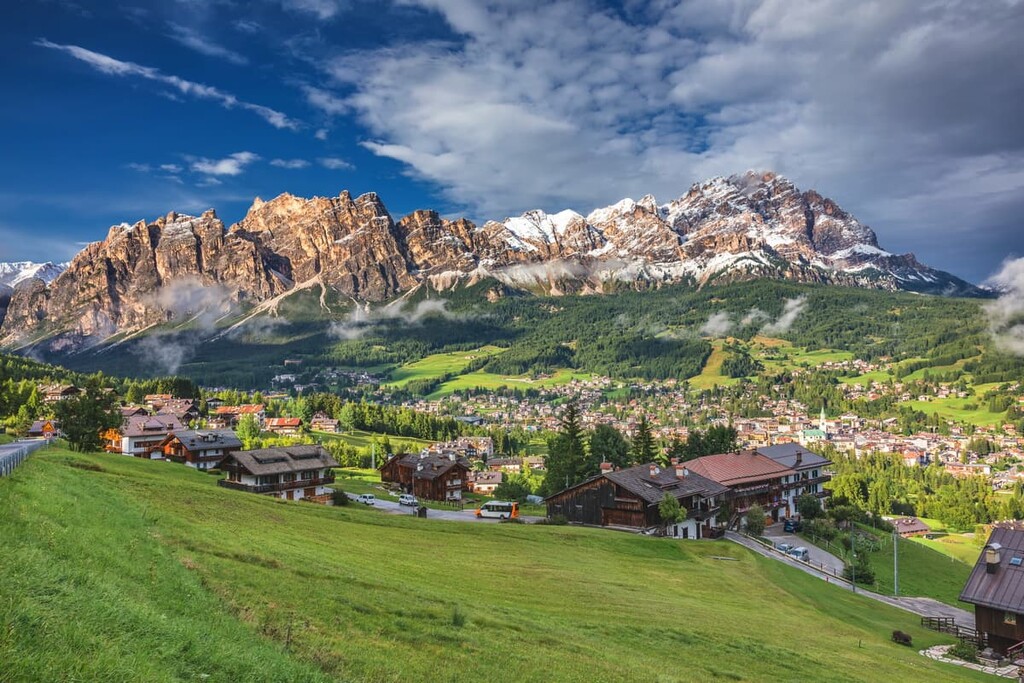
In my opinion, the town is worth a visit even if you don’t like touristy places, because it has a huge variety of architectural and cultural attractions. Here are just a few of them as an overview of what not to miss during your visit:
The official tourist website: Dolomiti.org/en/cortina.

Explore Gruppo del Cristallo with the PeakVisor 3D Map and identify its summits.








